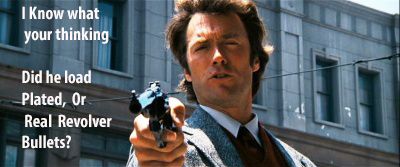Performing load development for a new 357M GP100 MC 4.2"
Using Berry's 158gr FP, new Star line Brass, and a light crimp from a Lee's FCD.
--Unique 6.8gr -7.0gr performed with fairly consistent accuracy (24 shots at each load). Same load that performs well in my 357M Blackhawk.
-- Titegroup 5.0gr was not consistent at all. Didn't expect much at all, just was an experiment.
--The surprise of the day was AA#5. It performed very well at 8.4 gr's a few days ago (and with no pressure signs), so tried it today @ 8.6gr and 8.8gr. Seems like the higher I am going the tighter the groupings, and while I don't see any overpressure signs the velocity might be getting a bit too high for plated.
Obviously I want to stick with AA#5 @ 8.8gr, or even venture a tad higher if possible. Problem is I cant find very little data for a Berrys 158gr FN using AA#5. The Powder manu only lists two loads @ 158gr:
158 HDY XTP Min 8.6 1,097 Max 9.7 1,256 CUP/COL 33,150 1.590
158 (L) LC SWC Min 8.6 1,100 Max 9.0 1,220 CUP/COL 34,500 1.590
Speer has a 158gr TMJ FN (closest thing to a Berry's FN ?)
Min 9.0 1,032 Max 10.00 1,152 CUP/COL 34,500 1.570
The Speer data sounds too high, and the Powder Manu doesn't have a good match. What to do? Continue testing at AA#5 @ 8.8, venture beyond to see if accuracy improves at the risk of plating failure? I don't have a chrono so looking for some input from those more experienced.
Using Berry's 158gr FP, new Star line Brass, and a light crimp from a Lee's FCD.
--Unique 6.8gr -7.0gr performed with fairly consistent accuracy (24 shots at each load). Same load that performs well in my 357M Blackhawk.
-- Titegroup 5.0gr was not consistent at all. Didn't expect much at all, just was an experiment.
--The surprise of the day was AA#5. It performed very well at 8.4 gr's a few days ago (and with no pressure signs), so tried it today @ 8.6gr and 8.8gr. Seems like the higher I am going the tighter the groupings, and while I don't see any overpressure signs the velocity might be getting a bit too high for plated.
Obviously I want to stick with AA#5 @ 8.8gr, or even venture a tad higher if possible. Problem is I cant find very little data for a Berrys 158gr FN using AA#5. The Powder manu only lists two loads @ 158gr:
158 HDY XTP Min 8.6 1,097 Max 9.7 1,256 CUP/COL 33,150 1.590
158 (L) LC SWC Min 8.6 1,100 Max 9.0 1,220 CUP/COL 34,500 1.590
Speer has a 158gr TMJ FN (closest thing to a Berry's FN ?)
Min 9.0 1,032 Max 10.00 1,152 CUP/COL 34,500 1.570
The Speer data sounds too high, and the Powder Manu doesn't have a good match. What to do? Continue testing at AA#5 @ 8.8, venture beyond to see if accuracy improves at the risk of plating failure? I don't have a chrono so looking for some input from those more experienced.

